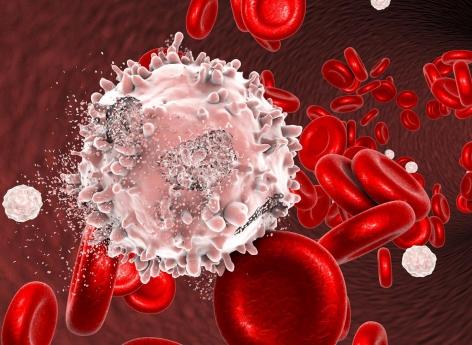THE ESSENTIAL
- Scientists have developed an artificial intelligence tool to analyze blood and bone marrow tests faster and more accurately.
- Once the data is processed, it offers a diagnosis to the doctor who must confirm or deny it.
–
Between 9,000 and 10,000 people are affected by leukemia each year in France, according to the Foundation for Medical Research. When an individual is healthy, they have a constant number of blood cells and lymphocytes (a type of white blood cell) circulating in the blood. But, in some cases, white blood cells accumulate abnormally and uncontrollably, which can lead to two types of cancer depending on the location. If it’s localized in the blood or bone marrow, it is leukemia, which is cancer of the blood. Whether it’s in the lymph nodes or the lymphatic system – a component of the immune system – the cancer is called lymphoma. The diagnosis of these cancers is usually made after analyzing the results of a blood test. If the doctor is in doubt, he may also perform a bone marrow exam.
Flow cytometry to collect data from each particle
According to a study published in the journal Patterns, a new artificial intelligence technique could improve the quality and speed of analyzes of these two samples. Usually these exams are processed via a method called flow cytometry. This makes it possible to measure the individual characteristics of each particle – cells, bacteria, parasites, etc. – in the blood or bone marrow, independently of other particles. Thus, the laboratory technicians collect data such as the size, shape, biological activity and complexity of each particle. Essential information for diagnosing cancer. In detail, with this flow cytometry, laboratories use antibodies that are put on the surface of the particles to be analyzed. These antibodies are coupled to fluorescent dyes, which are called markers because, thus colored, they are recognizable. These can also be used to detect small differences between cancerous and healthy cells. With flow cytometry, the signals emitted by each cell are recorded and are then collected and transcribed as graphs or statistics for example. It is with these results that doctors make a diagnosis.
Artificial intelligence to process data more quickly and precisely
The more precise the characterization of cancer cells, the better and faster the diagnosis. However, in normal times, it is very difficult to analyze all the characteristics of the data from flow cytometry because there are so many of them. The authors of this study have therefore developed an artificial intelligence tool capable of automatically and autonomously analyzing all this information. To create their algorithm, the team “trained” it with more than 30,000 data from patients with lymphoma. “Artificial intelligence takes full advantage of data and increases the speed and objectivity of diagnostics“, says Nanditha Mallesh, lead author of this study. Once the data is processed, artificial intelligence suggests a diagnosis to the doctor. “The purpose of using artificial intelligence is not to replace doctors, but to get the most out of the information contained in the data ”, explains Peter Krawitz, one of the authors. The practitioner must then confirm or deny this diagnostic proposal. Time saving and more finely analyzed data.
The advantage of this artificial intelligence is that it can be used by all laboratories, especially small ones who could not have developed such a technology themselves. Another advantage: it could also be used for other pathologies, such as the diagnosis of diseases linked to rheumatism, the examinations of which are often treated with the flow cytometry method.
–


![Pokémon Center Hoodie Sweater T-shirt Kids Pokémon Chums size 130 F / S New psl [5YOnfTiRseqcV] Pokémon Center Hoodie Sweater T-shirt Kids Pokémon Chums size 130 F / S New psl [5YOnfTiRseqcV]](https://i.ebayimg.com/images/g/rYoAAOSwdPJgU4Ml/s-l400.png)